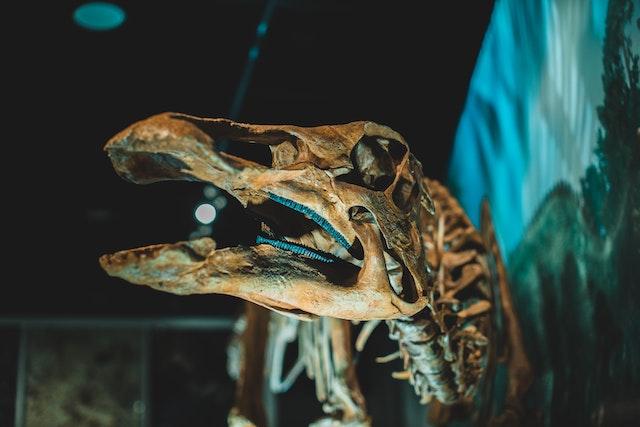Do Dinosaurs Have Ears? Explore Amazing Facts

Have you ever wondered do dinosaurs have ears and if they could hear well? From the fossil records, scientists have been able to uncover the answer to this age-old question. We will let you in on this article discussion about the question “Do dinosaurs have ears?” And facts about dinosaur ears.
Do Dinosaurs Have Ears?
Yes, dinosaurs did have ears. It is believed that they had both inner and outer ears.
The inner ear of a dinosaur would have been similar to that of a modern bird, with a cochlea, semicircular canals, and a vestibule. The cochlea is responsible for hearing, while the semicircular canals and vestibule are responsible for the balance. The inner ear of a dinosaur would have been filled with fluid, just like a modern bird.
Dinosaur Hearing Anatomy
The outer ear of a dinosaur would have been similar to that of a modern reptile, with a tympanic membrane and a tympanic cavity. The tympanic membrane is a thin membrane that vibrates when sound waves hit it, and the tympanic cavity is a hollow chamber that amplifies sound waves. The outer ear of a dinosaur would have been covered in scales, just like a modern reptile.
Examining the Evidence–Do Dinosaurs Have Ears
Whether dinosaurs had ears revealing fascinating aspects of their biology and how they interacted with their environment. The question “Do dinosaurs have ears?” leads us to understand the auditory capabilities of these ancient creatures, similar to those of modern reptiles.
Fossil Evidence–Do Dinosaurs Have Ears
When it comes to fossil evidence, do dinosaurs have ears? The evidence is limited. This is because the soft tissue of the ear is not preserved in the fossil record. However, some clues can be used to infer the question, Do dinosaurs have ears? And what may have looked like.
One of the most common clues is the presence of a bony structure called an external auditory meatus. This is a tube-like structure that is found in the skulls of many dinosaurs, including theropods, sauropods, and ornithischians. This structure is thought to have been used to house the external ear, and it is believed to have been covered in soft tissue.
Ear Bone Evidence
Another clue supporting the inquiry “Do dinosaurs have ears?” is the presence of a bony structure called a tympanic membrane. This thin sheet of bone, found in the skulls of some dinosaurs, including theropods and ornithischians, is thought to have been used to house the middle ear and is believed to have been covered in soft tissue.
Finally, some fossilized dinosaur skulls have been found with impressions of soft tissue around the external auditory meatus and tympanic membrane. These impressions can provide clues about the shape and size of the dinosaur’s ear.
Comparative Anatomy–Do Dinosaurs Have Ears
In addition to fossil evidence, scientists can also use comparative anatomy to infer what dinosaur ears may have looked like. Comparative anatomy is the study of the similarities and differences between the anatomy of different species.
Inferring Dinosaur Ears
By comparing the anatomy of living animals to that of extinct species, scientists can make educated guesses about the anatomy of extinct species. For example, by comparing the anatomy of living birds and reptiles to that of extinct dinosaurs, scientists can make educated guesses about the anatomy of dinosaur ears.
Based on this comparison, scientists believe that dinosaur ears were likely similar in shape and size to those of modern birds and reptiles. This means that dinosaur ears were likely small and rounded, and they were likely covered in soft tissue.
Do Dinosaurs Have Ears? If Yes, Could Dinosaurs Hear Well?
Similar animals with internal ears are known to have good hearing. It is difficult to know for certain how well dinosaurs could hear, as their ears have not been preserved in the fossil record. However, we can make some educated guesses based on the hearing abilities of similar animals with internal ears.
Most modern reptiles, such as crocodiles and lizards, have good hearing. They can detect low-frequency sounds, such as those made by other animals, and can even detect some higher-frequency sounds. This suggests that dinosaurs may have had similar hearing abilities.
Ear Structure
The structure of the inner ear of dinosaurs is also similar to that of modern reptiles. This suggests that they may have had similar hearing abilities. The inner ear of dinosaurs is composed of three semicircular canals, which are responsible for detecting sound waves and helping the animal to maintain balance.
This suggests that dinosaurs may have been able to detect sound waves and use them to orient themselves in their environment.
But what about dinosaurs? Do Dinosaurs Have Ears?
What did their ears look like? Some researchers believe that theropods, such as Tyrannosaurus rex, had external ears that were similar to those of modern birds. Others suggest that theropods had ears that were more like those of modern lizards.
Sue The Trex Fossil
The stapes bone found in Sue’s skull is compelling evidence that dinosaurs had well-developed hearing, adding to the discourse on “Do dinosaurs have ears?” The fossil record also provides us with evidence of the inner ears of dinosaurs.
For example, the stapes bone found in Sue’s skull is similar to the stapes found in modern birds and reptiles, suggesting that dinosaurs had inner ears that were akin to those of modern birds and reptiles. This comparison deepens our exploration of “Do dinosaurs have ears?”
But what did their ears look like? Unfortunately, the fossil record doesn’t provide us with a clear answer. We know that some dinosaurs had external ears, but it’s unclear how they were structured, further fueling the curiosity around “Do dinosaurs have ears?”
Modern Birds and Reptiles
In addition to the fossil record, scientists have also studied the anatomy of modern birds and reptiles to gain insight into the hearing of dinosaurs. For example, some researchers have studied the anatomy of modern birds and reptiles to determine how sound waves travel through the ear. This research has provided us with valuable information about the hearing of dinosaurs.
Do Dinosaurs Have Ears?
What Dinosaur Had The Best Hearing? Although dinosaurs have been extinct for millions of years, scientists have been able to make some educated assumptions about which dinosaurs had the best hearing. By studying the anatomy of their skulls and the environment they lived in, researchers have been able to piece together a picture of the dinosaurs that likely had the best hearing.
Two dinosaurs, the Llukalkan aliocranianus, and the Shuvuuia deserti, had just the best hearing! Let’s take a look at these two incredible creatures and their remarkable sense of hearing.
Llukalkan aliocranianuss
The 3D models revealed that the Llukalkan aliocranianus brain had a slightly more developed part of the brain that is responsible for perceiving sound, leading to speculation about “Do dinosaurs have ears?” and their auditory capabilities.
This part of the brain, known as the auditory cortex, is responsible for processing sound information. The fact that this part of the brain was more developed in Llukalkan aliocranianus suggests that it may have had an advantage in terms of hearing and perceiving sound, further intriguing those asking, “Do dinosaurs have ears?”
Shuvuuia deserti
Shuvuuia deserti was first discovered in the mid-1990s, but a new analysis of its inner ear bones has revealed that it may have been a nocturnal hunter, similar to modern owls, hinting at the question, “Do dinosaurs have ears?” and their hearing abilities.
S. Deserti’s Hearing Marvel
The analyzed 3D scans of S. deserti’s inner ear showed that it had a very large lagena, a structure responsible for hearing. The larger the lagena relative to the skull, the more sensitively an animal can hear – and this one was bigger than researchers had ever seen in a dinosaur.
This suggests that S. deserti had remarkable hearing, which would have been advantageous for hunting at night, adding a fascinating layer to our understanding of dinosaur sensory capabilities, particularly in the context of “Do dinosaurs have ears?”
Night Vision
In addition to its remarkable hearing, S. deserti also had well-honed night vision, much better than that of other dinosaurs and most modern birds, shedding light on the question, “Do dinosaurs have ears?” and their sensory adaptations.
This enhanced night vision would have been an advantage for hunting in the dark, as it would have allowed the creature to spot its prey more easily, further expanding our understanding of dinosaur sensory capabilities in the context of “Do dinosaurs have ears?”
In Summary
Well, it turns out that dinosaurs may have had ears to hear with, answering the intriguing question, “Do dinosaurs have ears?” This revelation suggests they were capable of making some pretty loud noises, indicating a prehistoric world alive with the diverse sounds of dinosaur calls and communications, a fascinating conclusion to our exploration of “Do dinosaurs have ears?”
More roaring facts and knowledge about dinosaurs at Dinosaurzus!

Top posts
related articles
Discover the Awesome Top 10 Longest Dinosaur Names
Dinosaurs, the ancient giants that once roamed the Earth, continue to capture our imagination. While
Discover the Amazing Dinosaur with 500 Teeth
Dinosaurs have always fascinated us with their colossal size, unique features, and intriguing mysteries. One
The Acheroraptor: An Insight into a Tiny but Fierce Dinosaur
The dinosaur world is undoubtedly fascinating, and the relative discovery of the acheroraptor is no
Epic Tale: Cryolophosaurus, Rise of the King
Cryolophosaurus, also known as the ‘Antarctic King’, was a fierce and fascinating dinosaur that existed
Torosaurus: The Horned Dinosaur with a Mysterious Identity
Dinosaurs don’t exist anymore, but their fossils still fascinate us. Paleontologists scour the earth to
Exploring the Wondrous World of Corythosaurus
The world of dinosaurs never stops fantastic us. From the huge T-rex to the tiny


